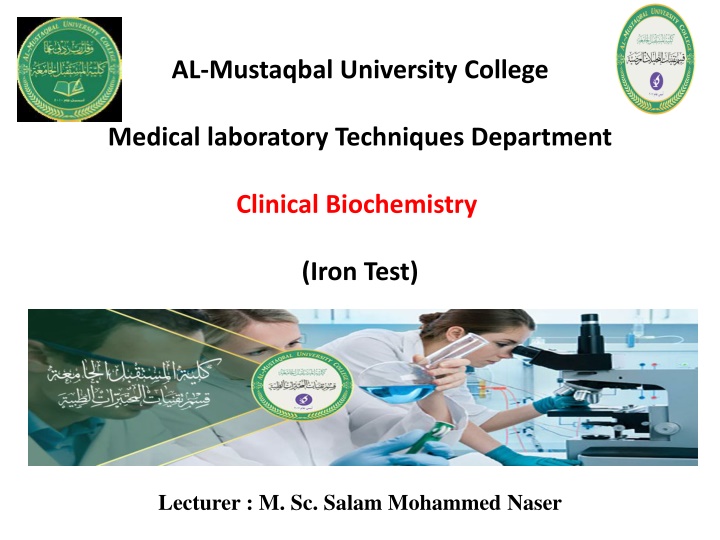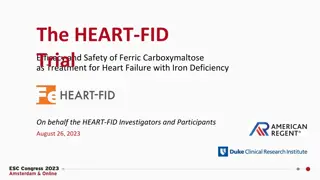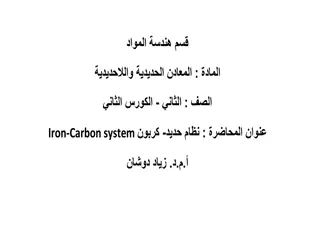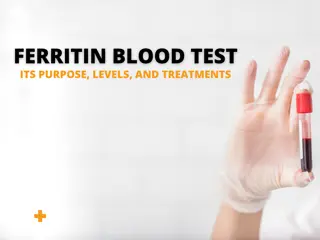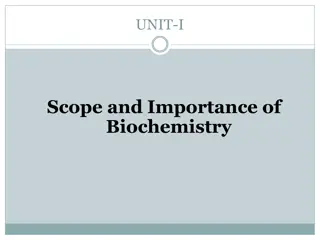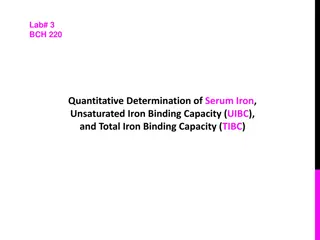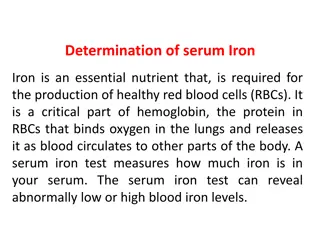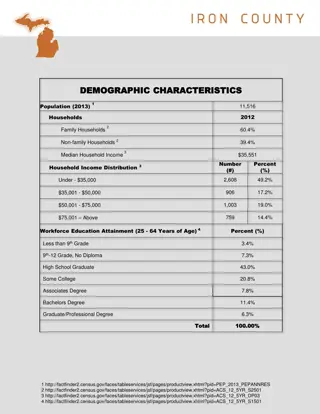Iron Test in Clinical Biochemistry
Iron is an essential element obtained from food and plays a crucial role in oxygen transport and enzyme synthesis in the body. The iron test measures iron levels in the blood associated with transferrin, ferritin, and total iron-binding capacity to assess deficiencies or excess. Learn about the significance, procedure, and types of iron blood tests. Explore the conditions related to iron deficiency and excess, along with when the examination is recommended. Discover the laboratory devices and tools used in conducting iron tests in the medical laboratory techniques department.
Download Presentation

Please find below an Image/Link to download the presentation.
The content on the website is provided AS IS for your information and personal use only. It may not be sold, licensed, or shared on other websites without obtaining consent from the author.If you encounter any issues during the download, it is possible that the publisher has removed the file from their server.
You are allowed to download the files provided on this website for personal or commercial use, subject to the condition that they are used lawfully. All files are the property of their respective owners.
The content on the website is provided AS IS for your information and personal use only. It may not be sold, licensed, or shared on other websites without obtaining consent from the author.
E N D
Presentation Transcript
AL-Mustaqbal University College Medical laboratory Techniques Department Clinical Biochemistry (Iron Test) Lecturer : M. Sc. Salam Mohammed Naser
IRON Iron is one of the elements we get from food, and it is an essential component in the process of building many materials that connect oxygen to the blood and muscles. It is also considered one of the important elements in the synthesis of many enzymes in the body. Iron is absorbed in the intestine, and from there it travels into the blood. In the blood, iron binds to a protein called transferrin, which transports iron into cells, primarily the bone marrow, where red blood cells are produced. The excess iron binds to another protein called ferritin.
The Iron Test The iron test measures the level of iron in the blood associated with transferrin, in addition to checking the total transferrin amount and the amount of ferritin. These tests indicate the amount of iron in the human body, and whether the person suffers from a deficiency or excess of iron. In cases of iron deficiency, the level of iron and ferritin decreases, while, in turn, the level of transferrin increases.
The Iron Test These conditions (iron deficiency) usually result from bleeding (such as menstrual bleeding), as well as from disturbances in absorption, and a lack of iron in the diet. the process of iron In cases of an excess of iron, the level of iron and ferritin rises, in contrast to a decrease in the level of transferrin in the blood
When is the examination performed? A blood iron level test is performed in the following cases: 1. An iron deficiency for example in cases of anemia (lack of hemoglobin). 2. An excess of iron is suspected, which may be caused by hemochromatosis disease. 3. In order to assess the patient's nutritional status (for example if he is malnourished). a genetic
Types of iron blood test Serum iron test. Transferrin test. Total Iron Binding Capacity (TIBC). Transferrin saturation. Serum ferritin
Laboratory devices and tools 1- Spectrophotometer 2- Centrifuges 3- Water bath 4- Micropipettes 5- Tubes, cups, cuvettes, tourniquet, syringes ,cotton, plain tubes, yellow and blue tip s 6-kit IRON
- Procedure: 1- Take the blood from the person. 2- Centrifuge the blood to gets the serum. 3-The additions as in the shown Table(1,2): Blank Standar d 1mL Test Blank Standar d Test Workin g reagent Standar d (R2) Serum Distill water 1 mL 1mL Reagent (R1) 1 mL 1mL 1mL Standar d (R2) ----- 200 L ----- ----- 200 L ----- ----- 200 L ----- ----- 200 L ----- Serum Distill water ----- 200 L ----- ----- 200 L -----
- Procedure: 4-Mix well and let for 5 minutes at room temperature. 5- Read the absorbance for standard and test against the blank at wave length 600 nm.
Calculations:- Con. of test = (A2-A1) of test/ (A2-A1)of standard) *Con. Of Stad.(200 mg per 100 ml)
Normal value:- Men: 50-175 mg per 100 ml, or 8.9-31.3 mol / L Women: 40-150 mg per 100 ml, or 7.2-26.8 mol / L Children: 50-120 mg per 100 ml, or 9-21.5 mol / L
Analysis of the results Increased transferrin: hemochromatosis / iron storage disease due to thalassemia or vitamin B6 deficiency, hemolytic anemia. Transferrin deficiency: iron deficiency anemia, chronic disease anemia
